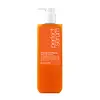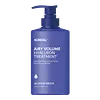What's inside
What's inside
 Key Ingredients
Key Ingredients

 Benefits
Benefits

 Concerns
Concerns

 Ingredients Side-by-side
Ingredients Side-by-side

Water
Skin ConditioningGlycerin
HumectantDipropylene Glycol
HumectantCetyl Alcohol
EmollientStearyl Alcohol
EmollientDimethicone
EmollientBehentrimonium Chloride
PreservativeIsopropyl Alcohol
SolventParfum
MaskingHydroxyethylcellulose
Emulsion StabilisingEthylhexylglycerin
Skin ConditioningDisodium EDTA
Hc Yellow No. 4
CI 19140
Cosmetic ColorantTocopherol
AntioxidantArgania Spinosa Kernel Oil
EmollientAbies Alba Seed Oil
AntimicrobialOlea Europaea Fruit Oil
MaskingSimmondsia Chinensis Seed Oil
EmollientCamellia Seed Oil
Cocos Nucifera Oil
MaskingCI 17200
Cosmetic ColorantBlue 1 Lake
Cosmetic ColorantCoco-Caprylate/Caprate
EmollientSclerocarya Birrea Seed Oil
HumectantGlycolipids
Skin ConditioningWater, Glycerin, Dipropylene Glycol, Cetyl Alcohol, Stearyl Alcohol, Dimethicone, Behentrimonium Chloride, Isopropyl Alcohol, Parfum, Hydroxyethylcellulose, Ethylhexylglycerin, Disodium EDTA, Hc Yellow No. 4, CI 19140, Tocopherol, Argania Spinosa Kernel Oil, Abies Alba Seed Oil, Olea Europaea Fruit Oil, Simmondsia Chinensis Seed Oil, Camellia Seed Oil, Cocos Nucifera Oil, CI 17200, Blue 1 Lake, Coco-Caprylate/Caprate, Sclerocarya Birrea Seed Oil, Glycolipids
Water
Skin ConditioningGlycerin
HumectantBehentrimonium Chloride
PreservativeStearyl Alcohol
EmollientCetyl Alcohol
EmollientHelianthus Annuus Seed Oil
EmollientIsopropyl Alcohol
SolventHydroxyacetophenone
AntioxidantCaprylyl Glycol
EmollientGuar Hydroxypropyltrimonium Chloride
Skin ConditioningDisodium EDTA
Sea Water
HumectantButylene Glycol
HumectantDipropylene Glycol
Humectant1,2-Hexanediol
Skin ConditioningPanthenol
Skin ConditioningUndaria Pinnatifida Extract
Skin ConditioningLaminaria Japonica Extract
Skin ProtectingHydrogenated Lecithin
EmulsifyingSorbitan Olivate
EmulsifyingCetearyl Olivate
Hizikia Fusiforme Extract
Skin ConditioningSodium Hyaluronate
HumectantGluconolactone
Skin ConditioningCapryloyl Salicylic Acid
ExfoliatingBiotin
AntiseborrhoeicEcklonia Cava Extract
Skin ConditioningCodium Fragile Extract
Skin ConditioningSargassum Fulvellum Extract
Skin ConditioningGelidium Cartilagineum Extract
Skin ProtectingHydrolyzed Soy Protein
HumectantHydrolyzed Rice Protein
Skin ConditioningHydrolyzed Pea Protein
EmollientHydrolyzed Hazelnut Protein
Skin ConditioningHydrolyzed Barley Protein
Skin ConditioningHydroxypropyltrimonium Hyaluronate
Sodium Acetylated Hyaluronate
HumectantHydrolyzed Hyaluronic Acid
HumectantHyaluronic Acid
HumectantGlycine
BufferingSodium Hyaluronate Crosspolymer
HumectantHydrolyzed Sodium Hyaluronate
Skin ConditioningGlutamic Acid
HumectantArginine
MaskingPotassium Hyaluronate
Skin ConditioningParfum
MaskingLimonene
PerfumingLinalool
PerfumingWater, Glycerin, Behentrimonium Chloride, Stearyl Alcohol, Cetyl Alcohol, Helianthus Annuus Seed Oil, Isopropyl Alcohol, Hydroxyacetophenone, Caprylyl Glycol, Guar Hydroxypropyltrimonium Chloride, Disodium EDTA, Sea Water, Butylene Glycol, Dipropylene Glycol, 1,2-Hexanediol, Panthenol, Undaria Pinnatifida Extract, Laminaria Japonica Extract, Hydrogenated Lecithin, Sorbitan Olivate, Cetearyl Olivate, Hizikia Fusiforme Extract, Sodium Hyaluronate, Gluconolactone, Capryloyl Salicylic Acid, Biotin, Ecklonia Cava Extract, Codium Fragile Extract, Sargassum Fulvellum Extract, Gelidium Cartilagineum Extract, Hydrolyzed Soy Protein, Hydrolyzed Rice Protein, Hydrolyzed Pea Protein, Hydrolyzed Hazelnut Protein, Hydrolyzed Barley Protein, Hydroxypropyltrimonium Hyaluronate, Sodium Acetylated Hyaluronate, Hydrolyzed Hyaluronic Acid, Hyaluronic Acid, Glycine, Sodium Hyaluronate Crosspolymer, Hydrolyzed Sodium Hyaluronate, Glutamic Acid, Arginine, Potassium Hyaluronate, Parfum, Limonene, Linalool
 Reviews
Reviews

Ingredients Explained
These ingredients are found in both products.
Ingredients higher up in an ingredient list are typically present in a larger amount.
This ingredient is a preservative and often used for it's anti-static properties. You'll most likely see this ingredient in hair conditioners.
It does not cause irritation or sensitization in leave-on products at 1-5%.
Cetyl Alcohol is a fatty alcohol. Fatty Alcohols are most often used as an emollient or to thicken a product.
Its main roles are:
Though it has "alcohol" in the name, it is not related to denatured alcohol or ethyl alcohol.
The FDA allows products labeled "alcohol-free" to have fatty alcohols.
Learn more about Cetyl AlcoholDipropylene Glycol is a synthetically created humectant, stabilizer, and solvent.
This ingredient helps:
Dipropylene glycol is technically an alcohol, but it belongs to the glycol family (often considered part of the ‘good’ alcohols). This means it is hydrating and gentle on skin unlike drying solvent alcohols like denatured alcohol.
As a masking agent, Dipropylene Glycol can be used to cover the smell of other ingredients. However, it does not have a scent.
Studies show Dipropylene Glycol is considered safe to use in skincare.
Learn more about Dipropylene GlycolDisodium EDTA plays a role in making products more stable by aiding other preservatives.
It is a chelating agent, meaning it neutralizes metal ions that may be found in a product.
Disodium EDTA is a salt of edetic acid and is found to be safe in cosmetic ingredients.
Learn more about Disodium EDTAGlycerin is already naturally found in your skin. It helps moisturize and protect your skin.
A study from 2016 found glycerin to be more effective as a humectant than AHAs and hyaluronic acid.
As a humectant, it helps the skin stay hydrated by pulling moisture to your skin. The low molecular weight of glycerin allows it to pull moisture into the deeper layers of your skin.
Hydrated skin improves your skin barrier; Your skin barrier helps protect against irritants and bacteria.
Glycerin has also been found to have antimicrobial and antiviral properties. Due to these properties, glycerin is often used in wound and burn treatments.
In cosmetics, glycerin is usually derived from plants such as soybean or palm. However, it can also be sourced from animals, such as tallow or animal fat.
This ingredient is organic, colorless, odorless, and non-toxic.
Glycerin is the name for this ingredient in American English. British English uses Glycerol/Glycerine.
Learn more about GlycerinIsopropyl Alcohol is more commonly known as rubbing alcohol. It is most commonly used as a solvent, meaning it helps other ingredients dissolve.
This ingredient is an astringent alcohol. Astringent alcohols may also irritate skin as they high amounts may strip away your skin's natural oils.
Other types of astringent alcohols include:
According to the National Rosacea Society based in the US, you should be mindful of products with these alcohols in the top half of ingredients.
Any type of sanitizing product will have high amounts of alcohol to help kill bacteria and viruses.
Learn more about Isopropyl AlcoholParfum is a catch-all term for an ingredient or more that is used to give a scent to products.
Also called "fragrance", this ingredient can be a blend of hundreds of chemicals or plant oils. This means every product with "fragrance" or "parfum" in the ingredients list is a different mixture.
For instance, Habanolide is a proprietary trade name for a specific aroma chemical. When used as a fragrance ingredient in cosmetics, most aroma chemicals fall under the broad labeling category of “FRAGRANCE” or “PARFUM” according to EU and US regulations.
The term 'parfum' or 'fragrance' is not regulated in many countries. In many cases, it is up to the brand to define this term.
For instance, many brands choose to label themselves as "fragrance-free" because they are not using synthetic fragrances. However, their products may still contain ingredients such as essential oils that are considered a fragrance by INCI standards.
One example is Calendula flower extract. Calendula is an essential oil that still imparts a scent or 'fragrance'.
Depending on the blend, the ingredients in the mixture can cause allergies and sensitivities on the skin. Some ingredients that are known EU allergens include linalool and citronellol.
Parfum can also be used to mask or cover an unpleasant scent.
The bottom line is: not all fragrances/parfum/ingredients are created equally. If you are worried about fragrances, we recommend taking a closer look at an ingredient. And of course, we always recommend speaking with a professional.
Learn more about ParfumStearyl Alcohol is a type of fatty alcohol from stearic acid. It is a white, waxy compound used to emulsify ingredients.
Fatty Alcohols are most often used as an emollient or to thicken a product. Emollients help soothe and hydrate the skin by trapping moisture.
They are usually derived from natural fats and oils and therefore do not have the same drying or irritating effect as solvent alcohols. FDA allows products labeled "alcohol-free" to have fatty alcohols.
Learn more about Stearyl AlcoholWater. It's the most common cosmetic ingredient of all. You'll usually see it at the top of ingredient lists, meaning that it makes up the largest part of the product.
So why is it so popular? Water most often acts as a solvent - this means that it helps dissolve other ingredients into the formulation.
You'll also recognize water as that liquid we all need to stay alive. If you see this, drink a glass of water. Stay hydrated!
Learn more about Water